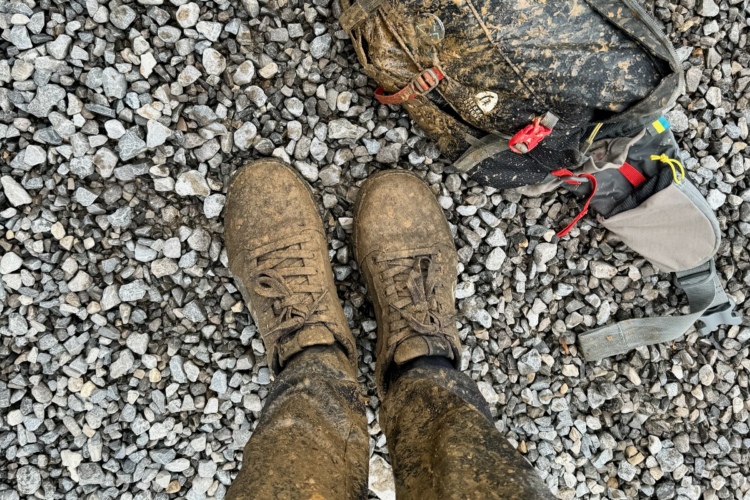
The Roval SL II carbon wheels are the brand’s lightest trail wheelset to date, but that’s not all. More importantly they’re optimized for strength and ride feel plus there are some interesting features you won’t find on competing MTB wheels. I’ve been testing a set on my trail bike since last fall and these wheels have proven to be incredibly solid and worry-free.
Roval Traverse SL 350 6B key specs
- Weight: 920g rear, 750g front (1,670g pair)
- Price: $1,500 pair, on sale for $1,125 as of press time
- Buy from Specialized
Specialized sums up the Roval Traverse SL II wheelset by saying it offers an optimized strength-to-weight ratio and excellent control. The carbon rims are 20mm deep with a 30mm internal width that’s ideal for 2.3- to 2.6in-wide tires. The front and rear rims utilize different carbon layups to give the rear extra strength and to deliver a tuned ride feel. My test set weighs 1,670g which is more than 80g lighter than the claimed weight.


Asymmetrical rims appear to be flip-flopped between the front and the rear, with a steeper, blockier transition on the drive side of the front wheel, and non-drive side of the rear wheel. My first thought upon noticing this was that one of the wheels was backward; if anything I suppose this helps balance the bike side to side in some way.
Reviewer profile height: 190cm (6’3″) weight: 75kg (165lb) testing zone: Southeast, USA
Another key characteristic of the Roval Traverse SL II is its ability to reduce the chance of pinch flats. Specialized says the wheels feature a patent-pending, “flat top” bead profile that can withstand nearly twice as much force as a standard rounded bead before causing a pinch flat. The 5mm rim bead width is among one of the widest I’ve encountered.
The Roval Traverse SL II wheels are laced two cross with 28 DT Swiss Competition Race J-Bend spokes front and rear. My test pair is built up with DT Swiss 350 hubs; there’s also a slightly pricier set available with DT Swiss 240 hubs.

Roval uses a special valve that screws directly into the rim and doesn’t require an external compression nut like most other valves. The advantage is said to be easier setup, fewer sealant clogs and less air leakage due to rim flex. Personally I find those external nuts annoying so this does seem to be an improvement, as long as you don’t accidentally strip the treads embedded in the rim.
The Roval Traverse SL II wheels come with a 2-year crash replacement warranty plus a lifetime warranty against manufacturing defects. There is a 275lb weight limit inclusive of rider and bike.



Installation
I set up the Roval Traverse SL II wheels on my Canyon Neuron trail bike and tested a few different tires on the rims. The Specialized Purgatory and Renegade S-Works tires proved a particularly tight fit, perhaps in part because Specialized is able to control the tolerances of both rim and tire. I also noticed the bead “pop” wasn’t as loud on those tires as with other wheels. A Maxxis Minion DHF tire went on the rim with much less effort and resulted in a much louder bead pop. I was able to air up all tires tubelessly with a regular floor pump.
The screw-in valve, which uses a 4mm hex tool to install, is pretty slick in my opinion. When removing valve cores I’ve found external compression nuts want to unscrew at the same time so you need to either hold it in place with your other hand, or in some cases grip it with a tool. You also need to keep it tight to form a tight seal with the gasket.
Once installed the Traverse SL II valve holds strong, and because the threads are on a wider part of the valve body, there’s a slightly larger internal diameter that makes adding sealant a little quicker and easier.
Riding the Roval Traverse SL II carbon wheels
On the trail the Roval Traverse SL II wheels proved to be the strong and silent type. For some reason I had it in my mind initially that these were alloy wheels (Roval does sell a set of alloy Traverse wheels), and I rode them accordingly. I smashed through rocks, tempted fate countless times by hopping concrete curbs and generally DGAF. I clanged the rims at least once or twice while running the lightweight, XC-oriented Renegade tire in the rear. Inadvertently I was putting Roval’s tagline, “carefully engineered to be ridden recklessly,” to the test.
Following a few months of riding I can’t see any signs of damage to the rims, nor did I experience a single pinch flat or burp even with lightweight tires. In fact all the tires I tested held air consistently during the test period. The rim tape appears to be holding strong with no new peeling or bubbling.


Some carbon mountain bike wheels can feel harsh; these do not. Specialized has upped the vertical compliance on the Roval Traverse SL II wheels this go around by decreasing the rim depth and altering the carbon layup. The upshot is a wheel that tracks the ground and feels comfortable without losing side-to-side precision. The front wheel stands ready to carve whatever line I choose while the rear tracks dutifully.
Share your Roval Traverse SL review
Throughout my testing the Roval Traverse SL II wheels were noticeably silent. There’s been no odd pinging or creaking to make me question the quality of the build.

The DT Swiss 350 hubs, with 10° of engagement, leave a bit to be desired. Unfortunately upgrading to the pricier Roval Traverse SL II 240 6B wheelset yields the same 36-point hub engagement which likely won’t be enough for the most discerning riders. (One could swap out the Ratchet 36 EXP for a 54 EXP on the 240 hub on the pricier Traverse SL II wheels for better engagement, but if it were me I’d just choose a comparably priced wheelset from another brand.)
Specialized touts the offset rim’s ability to deliver balanced spoke tension which should allow the wheel to run truer, longer. I checked the spoke tension on my rear wheel right out of the box and found the tensions to be within 10% for all but two of the drive side spokes as you can see from the chart below, left. All but two of the non drive side spoke tensions were within 5% of each other.
I checked again after a couple hundred miles of riding and found all of the rear wheel spoke tensions remained within 15% of one another, though the average spoke tension obviously decreased after breaking the wheel in. Exact spoke tension notwithstanding, the wheels continue to run dead true.


The Roval Traverse SL II wheels feature minimal graphics for a nicely subdued look. If only Maxxis could cool it with their blocky white and (worse) yellow logos…
It goes without saying that lighter carbon wheels pedal and climb better than heavier alloy ones. I might take some flack for saying so, but I can’t detect much of a weight difference between these wheels and the Stans Arch wheels I was running previously. Sure, on paper the Traverse SL II wheels should spin up more quickly, and they are roughly 150g lighter, but I can’t really feel it, even if it is a rotational mass difference. I did notice the weight of the Renegade tires versus the other trail tires I was running, but those are 300g lighter (per tire!) and tire weight is even further away from the axle than the rim.
Of course the advantages of carbon wheels go beyond weight and in terms of ride quality and strength I give the Roval Traverse SL II wheels an edge over most any alloy trail wheel.
Pros and cons of Roval Traverse SL
Pros
- Excellent ride feel and control
- Quality design and construction
- Durable with a tire-friendly bead
- Stealthy looks
Cons
- DT Swiss hub engagement is only 10°
- Lightweight, but may not be noticeable compared to alloy wheels
Bottom line
The Roval Traverse SL II wheelset delivers a comfy ride feel and excellent tracking with minimal maintenance worries.
- Price: $1,500 pair, on sale for $1,125 as of press time
- Buy from Specialized











2 Comments
Mar 4, 2024
Mar 4, 2024